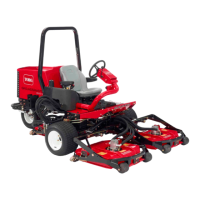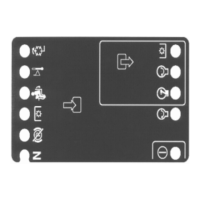27
5. Engage the parking brake. Depress the traction pedal
while engine is running and the PTO lever is
disengaged. The engine should stop within 2 seconds. If
engine stops, the switch is operating correctly; thus,
continue operation. If engine does not stop, there is a
malfunction in the interlock system that should be
corrected before beginning operation.
Pushing or Towing the Traction
Unit
In an emergency, the traction unit can be pushed or towed
for a very short distance. However, Toro does not
recommend this as standard procedure.
Important Do no push or tow the traction unit faster
than 2 to 3 MPH (3 to 4.8 km/h) because transmission may
be damaged. If traction unit must be moved a considerable
distance, transport it on a truck or trailer. Whenever traction
unit is pushed or towed, bypass valve must be open.
1. Reach under traction unit and rotate bypass valve
(Fig. 26) 1/2 to 1 turn counterclockwise. Opening the
valve opens an internal passage in the transmission,
thereby bypassing transmission oil. Because fluid is
bypassed, traction unit can be moved without damaging
the transmission.
1
Figure 26
1. Bypass valve
2. Before starting engine, close bypass valve by rotating it
clockwise until it is securely seated. Do not exceed 5 to
8 ft.-lb. (7 to 11 N⋅m). Do not start engine when valve is
open.
Important Running the machine with bypass valve
open will cause the transmission to overheat.
Operating Characteristics
Practice driving the machine because it has a hydrostatic
transmission and its characteristics are different than many
turf maintenance machines. Some points to consider when
operating the traction unit, cutting unit, or other implement
are the transmission, engine speed, load on the cutting
blades or other implement components, and the importance
of the brakes.
To maintain enough power for the traction unit and
implement while operating, regulate traction pedal to keep
engine rpm high and somewhat constant. A good rule to
follow is: decrease ground speed as the load on the
implement increases, and increase ground speed as the load
decreases.
Therefore, allow traction pedal to move backward as
engine rpm decrease, and depress pedal slowly as rpm
increase. By comparison, when driving from one work area
to another—with no load and cutting unit raised—have
throttle in FAST position and depress traction pedal slowly
but fully to attain maximum ground speed.
Another characteristic to consider is the operation of the
turning pedals that are connected to the brakes. The brakes
can be used to assist in turning the machine. However, use
them carefully, especially on soft or wet grass because the
turf may be torn accidentally. Another benefit of the turning
brakes is to maintain traction. For example: in some slope
conditions, the uphill wheel slips and loses traction. If this
situation occurs, depress uphill turn pedal gradually and
intermittently until the uphill wheel stops slipping, thus,
increasing traction on the downhill wheel.
Use extra care when operating machine on slopes. Always
have seat pivot retaining pin installed. Drive slowly and
avoid sharp turns on slopes to prevent roll overs. The
cutting deck must be lowered when going downhill for
steering control.
The grass deflector must always be installed and in lowest
position on the side discharge cutting unit.
Careless operation, combined with terrain angle,
ricochets, or improperly positioned safety guards
can lead to thrown object injuries.
A person or pet may suddenly appear in or near
the mowing area.
Stop mowing and do not resume mowing until the
area is cleared.
Warning
Before stopping the engine, disengage all controls and
move throttle to SLOW. Moving throttle to SLOW reduces
high engine rpm, noise, and vibration. Turn key to OFF to
stop engine.

